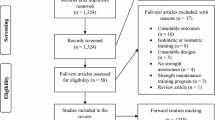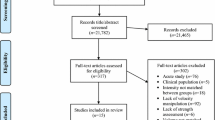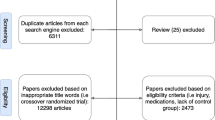Abstract
Resistance exercises can be considered to be multi-joint (MJ) or single-joint (SJ) in nature. Many strength coaches, trainers, and trainees believe that adding SJ exercises to a resistance training (RT) program may be required to optimize muscular size and strength. However, given that lack of time is a frequently cited barrier to exercise adoption, the time commitment resulting from these recommendations may not be convenient for many people. Therefore, it is important to find strategies that reduce the time commitment without negatively affecting results. The aim of this review was to analyze and discuss the present body of literature considering the acute responses to and long-term adaptations resulting from SJ and MJ exercise selection. Studies were deemed eligible for inclusion if they were experimental studies comparing the effects of MJ, SJ, or MJ + SJ on dependent variables; studies were excluded if they were reviews or abstracts only, if they involved clinical populations or persons with articular or musculoskeletal problems, or if the RT intervention was confounded by other factors. Taking these factors into account, a total of 23 studies were included. For the upper and lower limbs, analysis of surface electromyographic (sEMG) activation suggests that there are no differences between SJ and MJ exercises when comparing the prime movers. However, evidence is contrasting when considering the trunk extensor musculature. Only one study directly compared the effects of MJ and SJ on muscle recovery and the results suggest that SJ exercises resulted in increased muscle fatigue and soreness. Long-term studies comparing increases in muscle size and strength in the upper limbs reported no difference between SJ and MJ exercises and no additional effects when SJ exercises were included in an MJ exercise program. For the lumbar extensors, the studies reviewed tend to support the view that this muscle group may benefit from SJ exercise. People performing RT may not need to include SJ exercises in their program to obtain equivalent results in terms of muscle activation and long-term adaptations such as hypertrophy and strength. SJ exercises may only be necessary to strengthen lumbar extensors and to correct muscular imbalances.
Similar content being viewed by others
Notes
Lombard’s paradox suggests that the biaxial nature of the rectus femoris means that the net length does not change in hip and knee extension (e.g., MJ) exercises because just as the muscle shortens as a result of knee extension, it lengthens proportionally as a result of hip extension.
The two groups using these machines did not differ significantly and so were pooled to create a single group that trained without restraints, thus performing MJ trunk extension.
References
Kraemer WJ, Adams K, Cafarelli E, et al. American College of Sports Medicine position stand. Progression models in resistance training for healthy adults. Med Sci Sports Exerc. 2002;34(2):364–80.
Kraemer WJ, Ratamess NA. Fundamentals of resistance training: progression and exercise prescription. Med Sci Sports Exerc. 2004;36(4):674–88.
Newman AB, Kupelian V, Visser M, et al. Strength, but not muscle mass, is associated with mortality in the health, aging and body composition study cohort. J Gerontol A Biol Sci Med Sci. 2006;61(1):72–7.
Ruiz JR, Sui X, Lobelo F, et al. Association between muscular strength and mortality in men: prospective cohort study. BMJ. 2008;337:a439.
Artero EG, Lee DC, Ruiz JR, et al. A prospective study of muscular strength and all-cause mortality in men with hypertension. J Am Coll Cardiol. 2011;57(18):1831–7.
Srikanthan P, Karlamangla AS. Muscle mass index as a predictor of longevity in older adults. Am J Med. 2014;127(6):547–53.
Mavros Y, Kay S, Anderberg KA, et al. Changes in insulin resistance and HbA1c are related to exercise-mediated changes in body composition in older adults with type 2 diabetes: interim outcomes from the GREAT2DO trial. Diabetes Care. 2013;36(8):2372–9.
Magyari PM, Churilla JR. Association between lifting weights and metabolic syndrome among U.S. adults: 1999–2004 National Health and Nutrition Examination Survey. J Strength Cond Res. 2012;26(11):3113–7.
Minges KE, Magliano DJ, Owen N, et al. Associations of strength training with impaired glucose metabolism: the AusDiab Study. Med Sci Sports Exerc. 2013;45(2):299–303.
Ortega FB, Silventoinen K, Tynelius P, et al. Muscular strength in male adolescents and premature death: cohort study of one million participants. BMJ. 2012;345:e7279.
Tan B. Manipulating resistance training program variables to optimize maximum strength in men. J Strength Cond Res. 1999;13(3):289–304.
ACSM. American College of Sports Medicine position stand. Progression models in resistance training for healthy adults. Med Sci Sports Exerc. 2009;41(3):687–708.
Fisher J, Steele J, Bruce-Low S, et al. Evidence-based resistance training recommendations. Med Sport. 2011;15(3):147–62.
Fisher J, Steele J, Smith D. Evidence-based resistance training recommendations for muscular hypertrophy. Med Sport. 2013;17(4):217–35.
Haff GG, Triplett NT. Essentials of strength training and conditioning, 4th ed. Champaign: Human Kinetics; 2016.
Rutherford OM, Jones DA. The role of learning and coordination in strength training. Eur J Appl Physiol Occup Physiol. 1986;55(1):100–5.
Chilibeck PD, Calder AW, Sale DG, et al. A comparison of strength and muscle mass increases during resistance training in young women. Eur J Appl Physiol Occup Physiol. 1998;77(1–2):170–5.
Garber CE, Blissmer B, Deschenes MR, et al. American College of Sports Medicine position stand. Quantity and quality of exercise for developing and maintaining cardiorespiratory, musculoskeletal, and neuromotor fitness in apparently healthy adults: guidance for prescribing exercise. Med Sci Sports Exerc. 2011;43(7):1334–59.
Gómez-López M, Gallegos AG, Extremera AB. Perceived barriers by university students in the practice of physical activities. J Sports Sci Med. 2010;9(3):374–81.
Silliman K, Rodas-Fortier K, Neyman M. A survey of dietary and exercise habits and perceived barriers to following a healthy lifestyle in a college population. Calif J Health Promot. 2004;18(21):281.
Schutzer KA, Graves BS. Barriers and motivations to exercise in older adults. Prev Med. 2004;39(5):1056–61.
Eyler AA, Matson-Koffman D, Vest JR, et al. Environmental, policy, and cultural factors related to physical activity in a diverse sample of women: the Women’s Cardiovascular Health Network Project–summary and discussion. Women Health. 2002;36(2):123–34.
Trost SG, Owen N, Bauman AE, et al. Correlates of adults’ participation in physical activity: review and update. Med Sci Sports Exerc. 2002;34(12):1996–2001.
Gentil P, Soares SR, Pereira MC, et al. Effect of adding single-joint exercises to a multi-joint exercise resistance-training program on strength and hypertrophy in untrained subjects. Appl Physiol Nutr Metab. 2013;38(3):341–4.
Gentil P, Soares S, Bottaro M. Single vs. multi-joint resistance exercises: effects on muscle strength and hypertrophy. Asian. J Sports Med. 2015;6(2):e24057.
França HS, Branco PAN, Guedes Junior DP, et al. The effects of adding single-joint exercises to a multi-joint exercise resistance training program on upper body muscle strength and size in trained men. Appl Physiol Nutr Metab. 2015;40(8):822–6.
Giannakopoulos K, Beneka A, Malliou P, et al. Isolated vs. complex exercise in strengthening the rotator cuff muscle group. J Strength Cond Res. 2004;18(1):144–8.
Enocson AG, Berg HE, Vargas R, et al. Signal intensity of MR-images of thigh muscles following acute open- and closed chain kinetic knee extensor exercise—index of muscle use. Eur J Appl Physiol. 2005;94(4):357–63.
Escamilla RF, Fleisig GS, Zheng N, et al. Biomechanics of the knee during closed kinetic chain and open kinetic chain exercises. Med Sci Sports Exerc. 1998;30(4):556–69.
Wilk KE, Escamilla RF, Fleisig GS, et al. A comparison of tibiofemoral joint forces and electromyographic activity during open and closed kinetic chain exercises. Am J Sports Med. 1996;24(4):518–27.
Rocha Júnior VA, Gentil P, Oliveira E, et al. Comparação entre a atividade EMG do peitoral maior, deltóide anterior e tríceps braquial durante os exercícios supino reto e crucifixo. Rev Bras Med Esporte. 2007;13(1):51–4.
Welsch EA, Bird M, Mayhew JL. Electromyographic activity of the pectoralis major and anterior deltoid muscles during three upper-body lifts. J Strength Cond Res. 2005;19(2):449–52.
Greenhalgh T, Peacock R. Effectiveness and efficiency of search methods in systematic reviews of complex evidence: audit of primary sources. BMJ. 2005;331(7524):1064–5.
Mentzer M, Little J. High-intensity training: the Mike Mentzer way. New York: McGraw-Hill; 2003.
Hackett DA, Johnson NA, Chow CM. Training practices and ergogenic aids used by male bodybuilders. J Strength Cond Res. 2013;27(6):1609–17.
Gentil P. A nutrition and conditioning intervention for natural bodybuilding contest preparation: observations and suggestions. J Int Soc Sports Nutr. 2015;12:50.
Signorile JF, Weber B, Roll B, et al. An electromyographical comparison of the squat and knee extension exercises. J Strength Cond Res. 1994;8(3):178–83.
Alkner BA, Tesch PA, Berg HE. Quadriceps EMG/force relationship in knee extension and leg press. Med Sci Sports Exerc. 2000;32(2):459–63.
Ema R, Sakaguchi M, Akagi R, et al. Unique activation of the quadriceps femoris during single- and multi-joint exercises. Eur J Appl Physiol. 2016;116(5):1031–41.
Hoeger WWK, Hopkins DR, Barette SL, et al. Relationship between repetitions and selected percentages of one repetition maximum: a comparison between untrained and trained males and females. J Strength Cond Res. 1990;4(2):47–54.
Schoenfeld BJ, Contreras B, Willardson JM, et al. Muscle activation during low- versus high-load resistance training in well-trained men. Eur J Appl Physiol. 2014;114(12):2491–7.
Burd NA, Andrews RJ, West DW, et al. Muscle time under tension during resistance exercise stimulates differential muscle protein sub-fractional synthetic responses in men. J Physiol. 2012;590(Pt 2):351–62.
Campos YAC, da Silva SF. Comparison of electromyographic activity during the bench press and barbell pullover exercises. Motriz. 2014;20(2):200–5.
Franke A, Botton CE, Rodrigues R, et al. Analysis of anterior, middle and posterior deltoid activation during single and multijoint exercises. J Sports Med Phys Fit. 2015;55(7–8):714–21.
Steele J, Bruce-Low S, Smith D. A review of the specificity of exercises designed for conditioning the lumbar extensors. Br J Sports Med. 2015;49(5):291–7.
Udermann BE, Graves JE, Donelson RG, et al. Pelvic restraint effect on lumbar gluteal and hamstring muscle electromyographic activation. Arch Phys Med Rehabil. 1999;80(4):428–31.
Walsworth M. Lumbar paraspinal electromyographic activity during trunk extension exercises on two types of exercise machines. Electromyogr Clin Neurophysiol. 2004;44(4):201–7.
San Juan JG, Yaggie JA, Levy SS, et al. Effects of pelvic stabilization on lumbar muscle activity during dynamic exercise. J Strength Cond Res. 2005;19(4):903–7.
da Silva RA, Lariviere C, Arsenault AB, et al. Pelvic stabilization and semisitting position increase the specificity of back exercises. Med Sci Sports Exerc. 2009;41(2):435–43.
Lee HS. Enhanced muscle activity during lumbar extension exercise with pelvic stabilization. J Exerc Rehabil. 2015;11(6):372–7.
Soares S, Ferreira-Junior JB, Pereira MC, et al. Dissociated time course of muscle damage recovery between single- and multi-joint exercises in highly resistance-trained men. J Strength Cond Res. 2015;29(9):2594–9.
Korak JA, Green JM, O’Neal EK. Resistance training recovery: considerations for single vs. multijoint movements and upper vs. lower body muscles. Int J Exerc Sci. 2015;8(1):85–96.
Edinborough L, Fisher JP, Steele J. A comparison of the effect of kettlebell swings and isolated lumbar extension training on acute torque production of the lumbar extensors. J Strength Cond Res. 2016;30(5):1189–95.
Mendiguchia J, Garrues MA, Cronin JB, et al. Nonuniform changes in MRI measurements of the thigh muscles after two hamstring strengthening exercises. J Strength Cond Res. 2013;27(3):574–81.
Antonio J. Nonuniform response of skeletal muscle to heavy resistance training: can bodybuilders induce regional muscle hypertrophy? J Strength Cond Res. 2000;14(1):102–13.
Earp JE, Newton RU, Cormie P, et al. Inhomogeneous quadriceps femoris hypertrophy in response to strength and power training. Med Sci Sports Exerc. 2015;47(11):2389–97.
Graves JE, Webb DC, Pollock ML, et al. Pelvic stabilization during resistance training: its effect on the development of lumbar extension strength. Arch Phys Med Rehabil. 1994;75(2):210–5.
Mayer JM, Graves JE, Udermann BE, et al. Development of lumbar extension strength: effect of pelvic stabilization during resistance training. J Back Musculoskelet Rehabil. 2002;16(1):25–31.
Fisher J, Bruce-Low S, Smith D. A randomized trial to consider the effect of Romanian deadlift exercise on the development of lumbar extension strength. Phys Ther Sport. 2013;14(3):139–45.
Prior B, Jayaraman R, Reid R, et al. Biarticular and monoarticular muscle activation and injury in human quadriceps muscle. Eur J Appl Physiol. 2001;85(1–2):185–90.
Takahashi H, Kuno S, Miyamoto T, et al. Changes in magnetic resonance images in human skeletal muscle after eccentric exercise. Eur J Appl Physiol Occup Physiol. 1994;69(5):408–13.
Frost DM, Cronin J, Newton RU. A biomechanical evaluation of resistance: fundamental concepts for training and sports performance. Sports Med. 2010;40(4):303–26.
Lehman GJ. The influence of grip width and forearm pronation/supination on upper-body myoelectric activity during the flat bench press. J Strength Cond Res. 2005;19(3):587–91.
Wakahara T, Miyamoto N, Sugisaki N, et al. Association between regional differences in muscle activation in one session of resistance exercise and in muscle hypertrophy after resistance training. Eur J Appl Physiol. 2012;112(4):1569–76.
Wakahara T, Fukutani A, Kawakami Y, et al. Nonuniform muscle hypertrophy: its relation to muscle activation in training session. Med Sci Sports Exerc. 2013;45(11):2158–65.
Fonseca RM, Roschel H, Tricoli V, et al. Changes in exercises are more effective than in loading schemes to improve muscle strength. J Strength Cond Res. 2014;28(11):3085–92.
Ogasawara R, Thiebaud RS, Loenneke JP, et al. Time course for arm and chest muscle thickness changes following bench press training. Interv Med Appl Sci. 2012;4(4):217–20.
Maniar N, Shield AJ, Williams MD, et al. Hamstring strength and flexibility after hamstring strain injury: a systematic review and meta-analysis. Br J Sports Med. 2016;50(15):909–20.
Timmins RG, Bourne MN, Shield AJ, et al. Short biceps femoris fascicles and eccentric knee flexor weakness increase the risk of hamstring injury in elite football (soccer): a prospective cohort study. Br J Sports Med. 2015;. doi:10.1136/bjsports-2015-095362 (Epub 2015 Dec 16).
Fukuda TY, Melo WP, Zaffalon BM, et al. Hip posterolateral musculature strengthening in sedentary women with patellofemoral pain syndrome: a randomized controlled clinical trial with 1-year follow-up. J Orthop Sports Phys Ther. 2012;42(10):823–30.
Fukuda TY, Rossetto FM, Magalhaes E, et al. Short-term effects of hip abductors and lateral rotators strengthening in females with patellofemoral pain syndrome: a randomized controlled clinical trial. J Orthop Sports Phys Ther. 2010;40(11):736–42.
Clark BC, Manini TM, Mayer JM, et al. Electromyographic activity of the lumbar and hip extensors during dynamic trunk extension exercise. Arch Phys Med Rehabil. 2002;83(11):1547–52.
Clark BC, Manini TM, Ploutz-Snyder LL. Derecruitment of the lumbar musculature with fatiguing trunk extension exercise. Spine (Phila Pa 1976). 2003;28(3):282–7.
Bloomquist K, Langberg H, Karlsen S, et al. Effect of range of motion in heavy load squatting on muscle and tendon adaptations. Eur J Appl Physiol. 2013;113(8):2133–42.
Author information
Authors and Affiliations
Corresponding author
Ethics declarations
Funding
No sources of funding were used to assist in the preparation of this article.
Conflict of interest
Paulo Gentil, James Fisher, and James Steele declare that they have no conflicts of interest relevant to the content of this review.
Rights and permissions
About this article
Cite this article
Gentil, P., Fisher, J. & Steele, J. A Review of the Acute Effects and Long-Term Adaptations of Single- and Multi-Joint Exercises during Resistance Training. Sports Med 47, 843–855 (2017). https://doi.org/10.1007/s40279-016-0627-5
Published:
Issue Date:
DOI: https://doi.org/10.1007/s40279-016-0627-5




